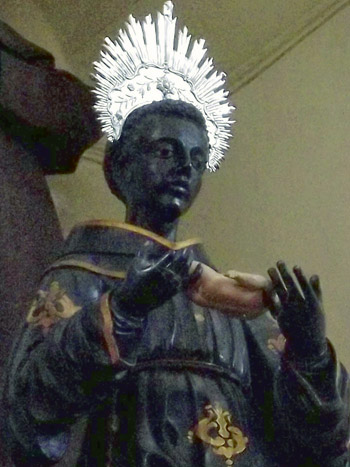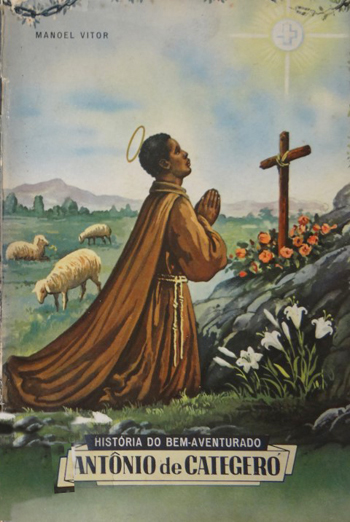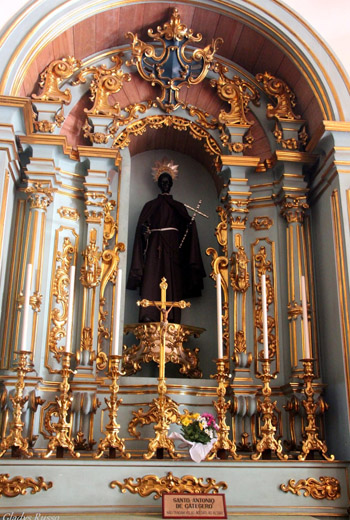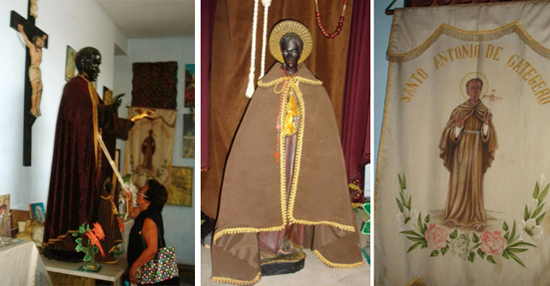The Saint of the Day
 |
 |
 |
 |
 |
 |
 |
St. Anthony of Carthage (Categeró) – March 14
St. Anthony of Carthage, or Santo Antonio Categeró, was born into the errors of Islam in North Africa in the late 15th century. He was sold as a slave when still young and became a simple shepherd in the hills of Sicily. There this unassuming African, sometimes called 'the Ethiopian' because of his black skin, began to acquire an admiration for the Catholic Faith of his masters.
 Anthony was a simple man, honest and cheerful, who tended his flocks diligently and never harbored malice toward anyone. He showed charity to all he encountered and was especially kind to the children of the countryside, who loved him and affectionately called him “Uncle Anthony.”
Anthony was a simple man, honest and cheerful, who tended his flocks diligently and never harbored malice toward anyone. He showed charity to all he encountered and was especially kind to the children of the countryside, who loved him and affectionately called him “Uncle Anthony.”
Through the piety of his master John Landavula, Anthony became aware of the Catholic Faith and began to inquire about it. After hearing the words of Christ, he converted and asked to be baptized in the Catholic Church. His master became both his teacher and his godfather.
From the day of his conversion Anthony adhered to Catholic principles with an ardent zeal. Contemplation of the life and death of Our Lord became his respite, and he pursued charity by feeding the poor with the excess cheese and milk of his flocks. Now he embraced his poverty and sought to accomplish much with nothing. Thus, he tried to conform his life to Christ, committing himself to overcoming his faults and serving the poor and discouraged. Many began to seek him out for advice in life’s hardships.
It came to pass that his master learned of the generosity of Anthony and how he gave milk and cheese from his flocks to the poor. He ordered Anthony to desist and was duly obeyed. Soon, however, the produce from the flock began to diminish significantly. Seeing the hand of God in this decline in yield, John Landavula returned permission to Anthony to resume his charity to the poor, and the production soon rose to levels that exceeded even the original good fortune.
Freedom to serve God
 It was not long before Anthony’s master, recognizing his virtue, granted him his freedom. For a few years he chose to continue working for his benevolent master. However, the day came that he sought to serve more rigorously the cause of Catholic charity and thus devoted himself totally to work in the hospital in Noto caring for the sick. He attended Mass daily and his frequent reading was the Lives of the Saints.
It was not long before Anthony’s master, recognizing his virtue, granted him his freedom. For a few years he chose to continue working for his benevolent master. However, the day came that he sought to serve more rigorously the cause of Catholic charity and thus devoted himself totally to work in the hospital in Noto caring for the sick. He attended Mass daily and his frequent reading was the Lives of the Saints.
Seeking to more perfectly imitate the Saints, Anthony entered religion and became a Third Order Franciscan. Renouncing his few earthly possessions he begged for his daily bread and gave to the poor even from the alms he received. He redoubled his work in the hospitals, always insisting that any good that came from his works be attributed to God.
Finally, after many years, he retired to the desert of Pizones. There he became a contemplative and spent his remaining years in prayer and meditation as a desert hermit.
In his own lifetime he was widely admired. When he would enter the town of Noto, the village people would flock to him, asking his intercession and hoping to gain healings. His patience in the face of adversity, his dedication to serving the most needy in society and his profound humility raised a general admiration for this African Saint, known colloquially as “the holy Negro.”
One day he became ill in Noto. Feeling his end was near, he asked to receive the Last Sacraments and devoutly surrendered his soul to God. He died on March 14, 1550, and his body was buried in the church of the Monastery of Friar Minors.
So many miracles took place through his intercession that his tomb was opened in 1599. His body was discovered intact and incorrupt, as fresh as if it had been buried that very day.
Saint of Brazil
 The Jesuits spread the devotion to St. Anthony of Categeró from Italy to Brazil. Soon many churches were dedicated to him, and more than 60 images represented this Holy African by the end of the Baroque period. The first Fraternity of Antonio Categeró was established in 1592.
The Jesuits spread the devotion to St. Anthony of Categeró from Italy to Brazil. Soon many churches were dedicated to him, and more than 60 images represented this Holy African by the end of the Baroque period. The first Fraternity of Antonio Categeró was established in 1592.
In Brazil St. Anthony became a symbol of comfort for the slaves brought over from Africa. Like them he had been taken from his home and thrust into a strange new land. Yet, it was this very stranger, a man who lacked wealth and power all his life, that did what even the rich and mighty could not; St. Anthony conquered the flesh, the Devil, and the world.
Brazilian churches were still being dedicated to St. Anthony Categeró as late as the 1950s, with thousands making pilgrimages to his shrines and relics. On January 24, 1978, the Bishop of Noto donated a bone from the Saint’s arm to the parish of Nossa Senhora do Ó [Our Lady of the Expectation] in São Paulo.
A beacon of sanctity
With abiding fervor St. Anthony renounced the things of this world, choosing instead the contemplation of God and the lowly task of serving the most deprived of society. With his begging bowl he provided alms for the poor, with his body he labored tending the sick, all the while with his spirit he prayed and contemplated God.
His popularity throughout Brazil - which proliferates with his statues - testifies to the solace and aid St. Anthony has brought to the blacks of the country.
His selflessness, his zeal, his patience in the face of misery and his undying ardor in the service of God serve as an example of sanctity for all in any time or place. Through him we realize that it is not health or comfort that matters most in life, but rather love for God and our neighbor.



St. Anthony of Carthage
Through the piety of his master John Landavula, Anthony became aware of the Catholic Faith and began to inquire about it. After hearing the words of Christ, he converted and asked to be baptized in the Catholic Church. His master became both his teacher and his godfather.
From the day of his conversion Anthony adhered to Catholic principles with an ardent zeal. Contemplation of the life and death of Our Lord became his respite, and he pursued charity by feeding the poor with the excess cheese and milk of his flocks. Now he embraced his poverty and sought to accomplish much with nothing. Thus, he tried to conform his life to Christ, committing himself to overcoming his faults and serving the poor and discouraged. Many began to seek him out for advice in life’s hardships.
It came to pass that his master learned of the generosity of Anthony and how he gave milk and cheese from his flocks to the poor. He ordered Anthony to desist and was duly obeyed. Soon, however, the produce from the flock began to diminish significantly. Seeing the hand of God in this decline in yield, John Landavula returned permission to Anthony to resume his charity to the poor, and the production soon rose to levels that exceeded even the original good fortune.
Freedom to serve God

St. Anthony depicted as a shepherd and Franciscan tertiary
Seeking to more perfectly imitate the Saints, Anthony entered religion and became a Third Order Franciscan. Renouncing his few earthly possessions he begged for his daily bread and gave to the poor even from the alms he received. He redoubled his work in the hospitals, always insisting that any good that came from his works be attributed to God.
Finally, after many years, he retired to the desert of Pizones. There he became a contemplative and spent his remaining years in prayer and meditation as a desert hermit.
In his own lifetime he was widely admired. When he would enter the town of Noto, the village people would flock to him, asking his intercession and hoping to gain healings. His patience in the face of adversity, his dedication to serving the most needy in society and his profound humility raised a general admiration for this African Saint, known colloquially as “the holy Negro.”
One day he became ill in Noto. Feeling his end was near, he asked to receive the Last Sacraments and devoutly surrendered his soul to God. He died on March 14, 1550, and his body was buried in the church of the Monastery of Friar Minors.
So many miracles took place through his intercession that his tomb was opened in 1599. His body was discovered intact and incorrupt, as fresh as if it had been buried that very day.
Saint of Brazil

The Franciscan Third Order Church in São Paulo honors St. Anthony with an ornate altar
In Brazil St. Anthony became a symbol of comfort for the slaves brought over from Africa. Like them he had been taken from his home and thrust into a strange new land. Yet, it was this very stranger, a man who lacked wealth and power all his life, that did what even the rich and mighty could not; St. Anthony conquered the flesh, the Devil, and the world.
Brazilian churches were still being dedicated to St. Anthony Categeró as late as the 1950s, with thousands making pilgrimages to his shrines and relics. On January 24, 1978, the Bishop of Noto donated a bone from the Saint’s arm to the parish of Nossa Senhora do Ó [Our Lady of the Expectation] in São Paulo.
A beacon of sanctity
With abiding fervor St. Anthony renounced the things of this world, choosing instead the contemplation of God and the lowly task of serving the most deprived of society. With his begging bowl he provided alms for the poor, with his body he labored tending the sick, all the while with his spirit he prayed and contemplated God.
His popularity throughout Brazil - which proliferates with his statues - testifies to the solace and aid St. Anthony has brought to the blacks of the country.
His selflessness, his zeal, his patience in the face of misery and his undying ardor in the service of God serve as an example of sanctity for all in any time or place. Through him we realize that it is not health or comfort that matters most in life, but rather love for God and our neighbor.

Statues and banners abound in Brazil that honor and celebrate St. Anthony

______________________
______________________
 Volume I |
 Volume II |
 Volume III |
 Volume IV |
 Volume V |
 Volume VI |
 Volume VII |
 Volume VIII |
 Volume IX |
 Volume X |
 Volume XI |
 Special Edition |


